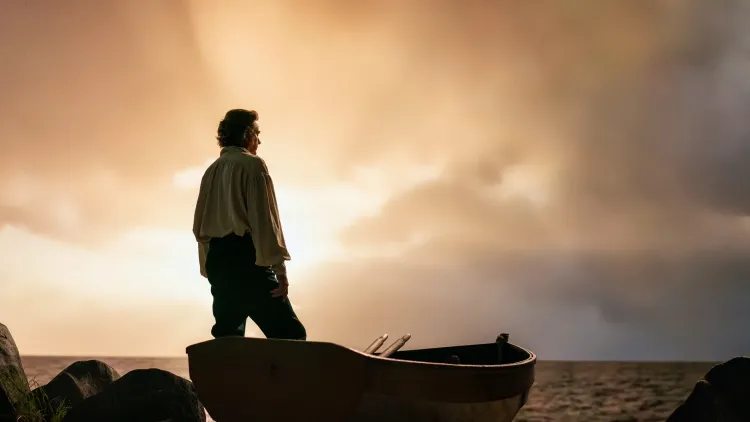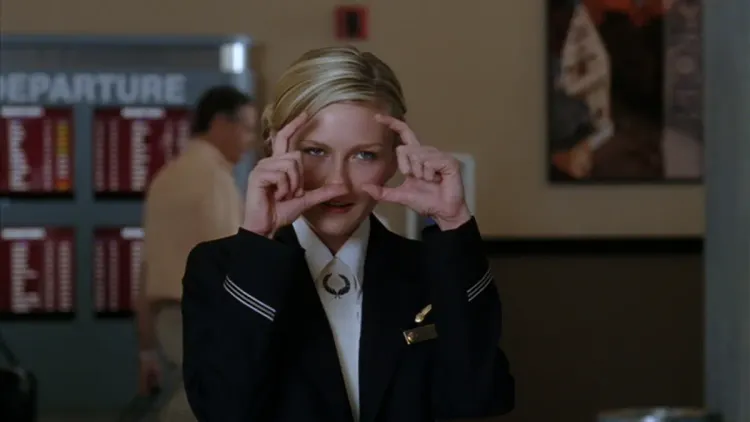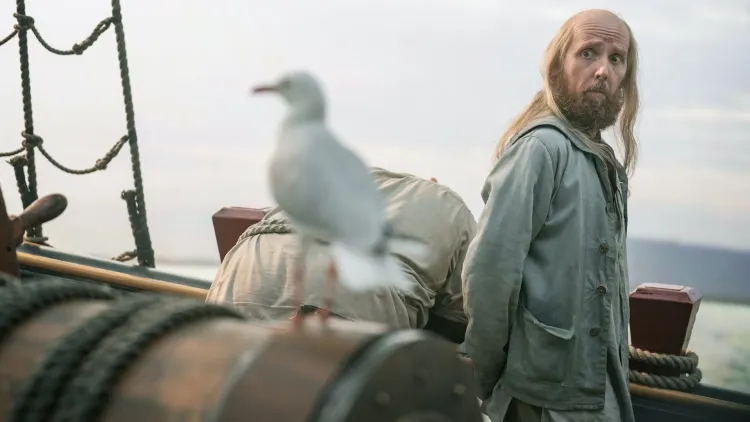Kirsten and Natalie #6: Mona Lisa Smile and Cold Mountain

(Kirsten and Natalie is a series tracing American womanhood as portrayed through the films of Kirsten Dunst and Natalie Portman. Read the introductory post here.)
The 2003 Oscar race was an odd one. The Lord of the Rings: The Return of the King entered the season as a prohibitive favorite. Even among Oscar pundits who didn't much like the Lord of the Rings films, there was a sense all other films were competing for second place.
Often when there is a prohibitive favorite at the Oscars, they drag a bunch of other nominees with them all through awards season. As an example, consider the 2015 Best Actor race. Leonardo DiCaprio seemed all but destined to finally win an Oscar for his work in The Revenant. So after nominators got done voting for him, they seemingly rubber-stamped the names of Bryan Cranston (for Trumbo), Michael Fassbender (for Steve Jobs), and Eddie Redmayne (for The Danish Girl) throughout awards season. The only "tension" came down to whether Johnny Depp (for Black Mass) or Matt Damon (for The Martian) would grab the final spot, and by Oscar nomination morning, it seemed clear Damon would be the choice.
Nominators knew they would vote for DiCaprio when it came time to select their winner. Therefore, they didn't challenge themselves to find other names to fill the category beyond those nominated at the earliest awards ceremonies. (They should have. Michael B. Jordan's work in Creed that year was mesmerizing, and Cranston's work in Trumbo is downright bad.)
However, the 2003 Best Picture race was more competitive once you got past the hobbits. Clint Eastwood's Mystic River seemed a safe enough bet, but for the other three spots, a host of films jostled for attention. Two of those films starred our heroes: Kirsten Dunst starred in the Mike Newell film Mona Lisa Smile, and Natalie Portman starred in Anthony Minghella's Cold Mountain. Both films were consummate Oscarbait, released in December (the 19th for Mona Lisa and the 25th for Mountain).
Both films featured incredibly middlebrow subject matter. Mona Lisa Smile starred Julia Roberts as an art teacher at 1950s Wellesley who inspires the girls in her classes to dream of something other than being homemakers. Cold Mountain adapted a best-selling, award-winning novel about a Confederate soldier deserting the Civil War to walk home to his beloved. (It starred the Oscar favorite trio of Jude Law, Nicole Kidman, and Renee Zellweger.) Both films missed Best Picture, but Cold Mountain nearly cracked the list, garnering seven other nominations. Mona Lisa Smile, however, failed to take off, felled by bad reviews.
Of the six installments of this series so far, the films covered in this one have left me by far the most indifferent. Both films are dull. Cold Mountain, at least, is very strange in places, and it occasionally has risible politics that at least provoked a reaction in me. But Mona Lisa Smile is a two-hour movie that already seems to be its own eight-episode Netflix adaptation for how laboriously it moves and how little it gets out of the gear established in its first frames. Oscarbait rarely ages well, and these two films are ample proof of that idea.
So we're not going to talk about the movies. I don't recommend them. No, we're going to talk about how these movies seemingly star the entirety of the rest of Dunst and Portman's "class."
A bitter lesson: Hollywood only ever has room for three, maybe four new lady stars at a time

Now, not every young white woman making a name for herself as an actress in 2003 is in these two movies. Scarlett Johansson was over in Lost in Translation (an eventual Best Picture nominee), and actors like Thora Birch and Gaby Hoffmann were already fading from the scene. (Hoffmann would eventually return; Birch not so much.)
Yet, in these two films, we can see work by Julia Stiles, Maggie Gyllenhaal, Jena Malone, Ginnifer Goodwin, Taryn Manning, and Laura Allen (in rough order of 2003 fame). (Allen is a bit of a stretch here, but she did seem like she might break out into a reliable supporting player for a while there.) In Mona Lisa Smile, the bit players include Krysten Ritter and Lily Rabe, for goodness sake. (Ritter looks very strange with a 1950s hairstyle.)
These actors went on to successful careers, though Stiles seemed much more ambivalent about fame. But only Dunst and Portman became legitimate movie stars around whom you could build a film. (I would argue Johansson joined their number by the end of the 2000s.) Why was that?
At any given time, Hollywood will only provide a handful of unproven actors a chance at a star turn. Then only a handful of those performers will become favorites of enough of the public to hold on as actual movie stars. So winnowing will always happen. It's a natural part of the process.
If we look at the top-billed stars of these films, we find Julia Roberts, Nicole Kidman, and Renee Zellweger, at the time, three of the most prominent woman stars of their generation. (Kidman was more of a prestige star than a movie star, but the same principles apply.) With Meg Ryan on a downswing after In the Cut (unfortunate because In the Cut rules) and Sandra Bullock in a bit of a slump, you could say these were the top three woman stars of the moment. I'd include Halle Berry, but she was also just about to make Catwoman, so. And within the next several years, Zellweger's fame would plummet, Kidman would fail to ignite as a commercial draw, and Roberts would slowly withdraw from the fame game. Bullock would surge back in front, a position she still probably holds.
The main draw for any movie actor won't necessarily be becoming as famous as possible. Yet I will not be the first to say that women do not receive the same chances as men in Hollywood and that those chances decrease considerably even for established stars as they age. Roberts and Kidman have done most of their recent work in television, and it's hard to blame them. That's where the chewy roles for women are.
Let's return to the generational cohort we're talking about, roughly born between 1975 and 1985, with Dunst and Portman right in the middle. Many of the women in these two films got shots at carrying their own films, particularly Stiles, but few got many shots, and a handful never got a shot at all.
Consider Goodwin (a favorite of mine). I don't need to make hypothetical the idea that she never received the same chances as a comparable male star. Goodwin's breakthrough role was on the NBC TV show Ed, which ran for four seasons and over 80 episodes between 2000 and 2004. In that series, she played a smart, wise-cracking teen girl, part of the show's younger ensemble, which included the slyly sardonic comedic performer Justin Long, a man who would be given several chances at movie stardom.
Goodwin and Long were born within two weeks of each other, and I would say they were equally well-known at their respective heights of fame. (You may have forgotten how big Once Upon a Time was, but Goodwin's residual checks surely have not.) Yet Long had a path to possible movie stardom through the comedies of the era, which was defined by the styles of Judd Apatow and Adam McKay, two filmmaking styles particularly friendly to a performer like Long. I like Long in many of his big-screen roles, but he had a path to movie stardom Goodwin (who took a couple of leading-ish parts in ensemble romcoms right as Hollywood stopped making them) just didn't.
Natalie Portman and Kirsten Dunst, at a crossroads

In 2003, Portman and Dunst had already established themselves as actors capable of carrying films. Each had a blockbuster franchise, and both had gotten multiple shots at carrying their own films, with Dunst's Bring It On proving a success. So taking a supporting part in an Oscar-y movie is easy to read as a good strategy at this point in both women's careers.
Yet of the two, only Dunst may have briefly entertained the thought that she could be nominated. She's by far the film's most prominent supporting part, and she has an arc where her character Betty goes from believing that women should stay in the home to contemplating law school and rooming with another young woman (with whom she will clearly fall in love). In a world where Mona Lisa Smile didn't struggle to get out of first gear, one could easily see an Oscar nomination for Dunst with that part.
Portman, meanwhile, is in maybe 10 minutes of Cold Mountain, in an unshowy part. She plays a war widow who invites the protagonist into her cabin on a long, cold night. (Nothing happens but mutually beneficial emotional support.) Later, the two fight off a trio of Union soldiers threatening her and her baby son. The showy supporting part in the film belongs to Zellweger, who is bad but in a compelling way that jolts the movie to life when she enters it at the 51-minute mark. (She would finally win her Oscar for the role.) Portman likely wasn't going to overcome that, but the goal of the part seems to be less awards attention and more a reminder that when she's dialed in (as she is here), Natalie Portman is a formidable performer.
Portman had been in college for several years at this point, which meant that almost all of her acting work had been fulfilling her contractual obligations to the Star Wars prequel trilogy, films that don't really offer actors loads to work with. Cold Mountain serves as a "hey, did you remember I can act?" reminder and as a nod to the fact that Portman is now an adult and can play, say, a young mother who is nearly the victim of sexual assault.
I'm thinking a lot about the other young women in these movies because the fortunes of Natalie Portman and Kirsten Dunst are also on the precipice of changing. We're about to enter a weird period when Portman becomes an awards darling — something like her generation's Nicole Kidman — while Dunst struggles to make things land. The precise moment that starts to happen is still a couple of entries away, but that also makes these two rather forgettable films all the more interesting when considering them today.
I used to frequent message boards where people talked at length about the Oscars and who would win the upcoming awards. The predominant attitude expressed toward actresses was that they were constantly in competition, with Kidman rising to destroy Cate Blanchett or what-have-you. The attitude was always that actresses were playthings, little dolls to have act out imagined, catty wars. When posting there, I struggled with that attitude. I think there are baseline misogyny problems with treating women as constantly one harsh word away from a catfight. I recognize the campiness inherent to a particular brand of (often but not always male) queerness in these performances. At the time, though, I felt uncomfortable because I didn't like the idea that I was in competition with other women my age, who didn't even realize that was the case. Then I interrogated that idea no further.
Our culture wants us to believe that women are always in competition for a handful of spots. That idea is, indeed, in the text of Mona Lisa Smile, where the girls of Wellesley are afforded a single spot in Yale law school. The transphobic attacks on trans woman athletes are rooted in lots of horrible notions, but they also seem to be based on this inherently misogynist idea: Women only get a certain number of seats at the table, so there'd better not be any unexpected competitors for those seats. We worked hard to scrabble that handful of seats away from men! And now they're being taken from us?
It's a false flag operation. The people taking seats away from women are never other women, whether trans or cis (for plenty of cis women of color have received similar pushback from white women with access to power). Natalie Portman and Kirsten Dunst weren't their generation's only two promising woman actors or even the most promising. They were just the two who rose to the top earliest, often by playing masculine fantasies and offering their own spins on those parts.
I always conclude these pieces by wondering what my little femme brain was stewing in when seeing these films, but I had started to grasp a better picture of who I was when these films came out. I saw sisterhood, sure, but I also saw a strange hierarchy, one that women didn't invent or even feel particularly comfortable existing within but one that we were made to perform nonetheless. And what do you do with that if you're a young trans woman, hoping against hope to not have to be herself? You might conclude the whole thing's not worth the effort. It is. It very much is. But it can be hard to hear that message over the din.

In August: Natalie Portman gets her first Oscar nomination for Closer, but do I like Kirsten Dunst's work in Eternal Sunshine of the Spotless Mind more? I just might! We're moving on to 2004, everybody! (Programming note: I try to keep these chronological, but I skipped past Garden State to pair it with Elizabethtown in the September installment. Get excited, America!)
Talk back to me: Which Mona Lisa Smile actor deserved better? And why didn't Jena Malone get to do anything cool in Cold Mountain? Riddle me that in the comments or by replying to the email.
What I've been up to: Over at Vox, I've written pieces about the astonishing Ethel Cain, the many ways adoption won't fill the gap in a Roe-less America, and Donald Trump as reality TV show president (say it with me again one last time).
Remember when then-President Donald Trump hurled a plate at a White House wall, spattering it with ketchup? You didn’t see that moment. You didn’t even know about it when it happened. But when Cassidy Hutchinson, a former aide to Mark Meadows, Trump’s chief of staff, told that story before the House select committee investigating the Capitol insurrection of January 6, 2021, odds are pretty good you could picture it. The ketchup wall was just one of many damning details in Hutchinson’s testimony, delivered on June 28. She also testified that Trump seemed intent on allowing heavily armed people to march on the Capitol, that he reportedly attempted to seize control of a vehicle from a Secret Service agent who wouldn’t drive him up to the Capitol, and that he was obsessed with the size of the crowd listening to his speech on that day. (With Trump, some things never change.)
Coming up on the paid version of Episodes: In the next couple of weeks, we'll have pieces on criminal justice as depicted in The Batman, the Isabel Sandoval film Lingua Franca, and nostalgia in 2022 American horror. Stick around for that!
Read me: I've recently been getting really into romance novels, a thing I started doing because I better wanted to understand the tropes to play around with them on Arden then came to very much delight in. I'm particularly enamored of romance novels where the spark arises between two women (surprising, I know). My most recent favorite in that regard is Alexandria Bellefleur's Written in the Stars, a fun, queer reinvention of Pride and Prejudice that is just cheesy enough to work. (Its follow-ups are pretty great, too, though one is about a woman and a man falling in love, which I believe was made illegal??)
Watch me: I had a blast watching Jenny Nicholson dissect the incredibly elaborate, bizarre world of pop culture-infused church Easter plays from a random church in Winnipeg. It's worth it just for when Iron Man starts singing after being crucified.
And another thing... I have been watching the early 2000s family drama Get Real on YouTube for some reason. The series gave Jesse Eisenberg and Anne Hathaway their starts, and it is... incredibly irritating and entertaining all the same? The guy who made it also went on to make the best seasons of Dexter, so...
Opening credits sequence of the week: It's time for you to care more about Lancelot Link: Secret Chimp.
A thing I had to look up: I cannot believe Justin Long and Ginnifer Goodwin's birthdays are so close. The universe wanted me to have this newsletter!
This week's reading music: "Mona Lisas and Mad Hatters" by Elton John
Episodes is published twice per week. Mondays alternate between a free edition on various topics and a subscriber-supported edition where I recap TV shows of interest. Fridays offer pop culture thoughts from freelance writers. The Friday edition and the biweekly recaps are only available to subscribers. Suggest topics for future installments via email or on Twitter. Read more of my work at Vox.





Member discussion